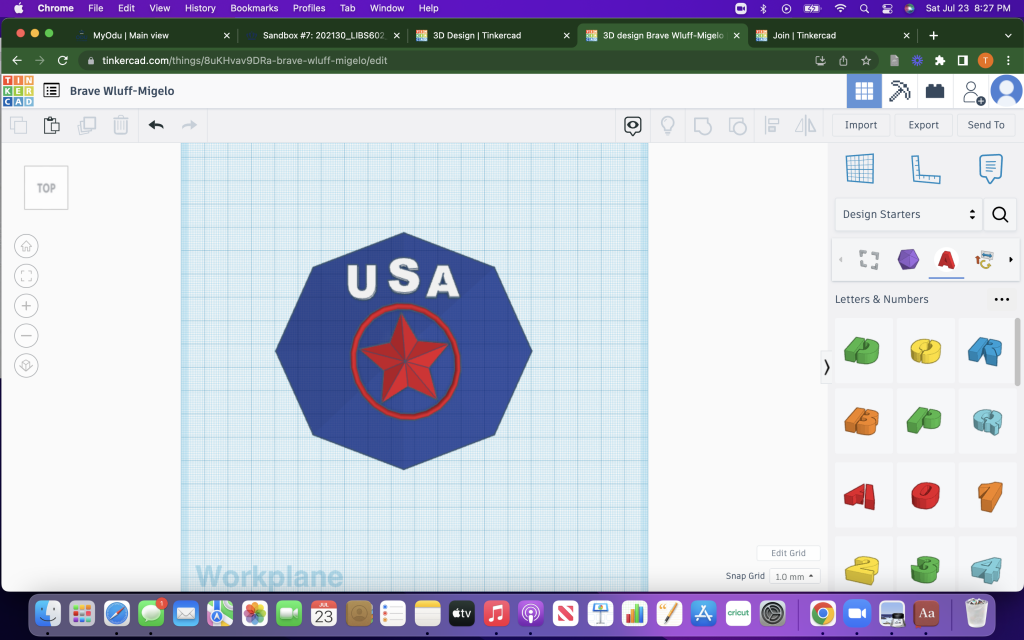3D Printing – Tinkercad
Because I have some experience with coding, I decided to try the 3D printing. My school has two 3D printers that are in the office of our technology assistant. My kindergarten students love watching the printer work and trying to guess what it is printing. In fact, I like watching it also. Sekinger’s (2019) observation that both students and adults are excited to watch the 3D printer at his school (The 3D reality section, para. 1) is true at my school also. I love that the 3D printer is in the library at Sekinger’s (2019) school. This gives all the students a chance to use and experience it. His belief “that a library should be a place of discovery and exhibition, innovation and connection” (Sekinger, 2019, introduction) helps creates a place where all students can make a connection.
Before attempting a 3D project, I started with the mini lessons on the Tinkercad site. I did not count these lessons as part of my designing hour. After going through them, I thought I would be able to zoom right through designing something. Boy, was I wrong! It was harder than it looked. First, I was trying to design a house but struggled with getting the roof on. So, I deleted it. A few tries and deletes later and with the hour ticking by, I decided on the USA shield. Honestly, I didn’t really know what it was going to be when I started designing it.

While the middle school students in Sekinger’s (2019) school are creating their own 3D designs after some lessons (The 3D reality section, para. 1), I fear younger students would struggle. Designing as a class with the librarian/teacher taking the lead would be fun and a good learning experience. Whether designing together as a class, small group or as an individual, students will be engaging in computational thinking. When designing for a 3D printer, students are “identifying problems, breaking apart or decomposing the problem into smaller parts, finding patterns, and designing solutions” (Libraries Ready to Code, 2018, para. 3).
References
Libraries Ready To {Code}. (2018). How computational thinking fits within library services. American Library Association. https://www.ala.org/tools/readytocode/how-computational-thinking-fits-within-library-services
Sekinger, N. (2019, February 28). Making a place for “3D” in our school library. IMADE3D. https://www.imade3d.com/2019/02/making-a-place-for-3d-in-our-school-library/
I like your shield! And I’m glad I’m not the only one that found 3D designing to be more difficult that it looks. I think you created a really unique item. Are you planning on printing it?
Thanks. I never really thought about printing it, but it would be cool.
I think your shield is very cool! I also wondered if perhaps Tinkercad might be too much for the younger grades. I can see older kids catching on to it very quickly but every post I’ve read about it mentions frustrations. I spent my hour coding since that was what I had the least amount of experience with. I need to carve out sometime to dive into Tinkercad myself.
It’s so cool your school has 3D printers already. You should definitely print your shield.
Nice job with your USA shield! Tinkercad is very challenging!! I was hoping I could make something to print, but it is going to take more hours to get something worth printing. I must have missed the mini-lessons, because maybe that would have helped me a little more.
I also found Tinkercad to be a bit of a struggle! I know I could have figured more out (and I should have gone through the tutorials, honestly, lol), but I didn’t want to spend more than an hour. Well done!
Great shield! I do like the idea of breaking apart, thinking about elements, and then creating. One thing I learned about technology when I got my Master’s in Instructional Technology is that you need to use the technology that is appropriate. Sometimes it is the computer, and sometimes it isn’t. I think for young children I would teach the same skills and processing, but with paper or building toys. Then, maybe (if I could do it) take their creation and show them how I do the same thing with the computer and print it. I’m thinking as I type here, but I like the idea! Contrats on your creation!
That is a good idea to first teach the skills and processing with paper or manipulative for younger students.
Great job with your design! I thought this would be much easier than it was, as well! I’m impressed your school has 3D printers. I think it is a wonderful experience for students to be able to create!